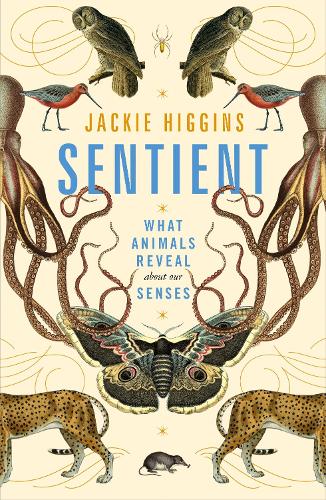
Sentient: What Animals Reveal About Our Senses
(Paperback)
Available Formats
Paperback
Published: 9th August 2022
Hardback
Published: 28th September 2021
Paperback
Published: 10th August 2021
Publishing Details
Sentient: What Animals Reveal About Our Senses
By (Author) Jackie Higgins
Pan Macmillan
Picador
10th August 2021
United Kingdom
Classifications
General
Non Fiction
Zoology and animal sciences
Evolution / Evolutionary biology
Human biology
573.87
Physical Properties
Paperback
352
Width 153mm, Height 234mm, Spine 27mm
420g
Description
Sentient assembles a menagerie of zoological creatures - from land, air, sea and all four corners of the globe - to understand what it means to be human. Through their eyes, ears, skins, tongues and noses, the furred, finned and feathered reveal how we sense and make sense of the world, as well as the untold scientific revolution stirring in the field of human perception. The harlequin mantis shrimp can throw a punch that can fracture aquarium walls but, more importantly, it has the ability to see a vast range of colours. The ears of the great grey owl have such unparalleled range and sensitivity that they can hear twenty decibels lower than the human ear. The star-nosed mole barely fills a human hand, seldom ventures above ground and poses little threat unless you are an earthworm, but its miraculous nose allows it to catch those worms at astonishing speed - as little as one hundred and twenty milliseconds. Here, too, we meet the four-eyed spookfish and its dark vision; the vampire bat and its remarkable powers of touch; the bloodhound and its hundreds of millions of scent receptors, as well as the bar-tailed godwit, the common octopus, giant peacocks, cheetahs and golden orb-weaving spiders. Each of these extraordinary creatures illustrates the sensory powers that lie dormant within us. In this captivating book, Jackie Higgins explores this evolutionary heritage and, in doing so, enables us to subconsciously engage with the world in ways we never knew possible.
Author Bio
Jackie Higgins grew up by the sea in Cornwall and has always been fascinated by the natural world. She is a television documentary director and writer. She read zoology at Oxford University, as a student of Richard Dawkins. In her first job at Oxford Scientific Films, she made wildlife films for a decade, for BBC stands such as The Natural World and Wildlife on One, as well as for Channel 4, National Geographic and The Discovery Channel. She then moved in-house at the BBC for a further decade, where she worked in their Science Department: researching and writing, directing and producing films across the board, from Horizon to Tomorrow's World.
